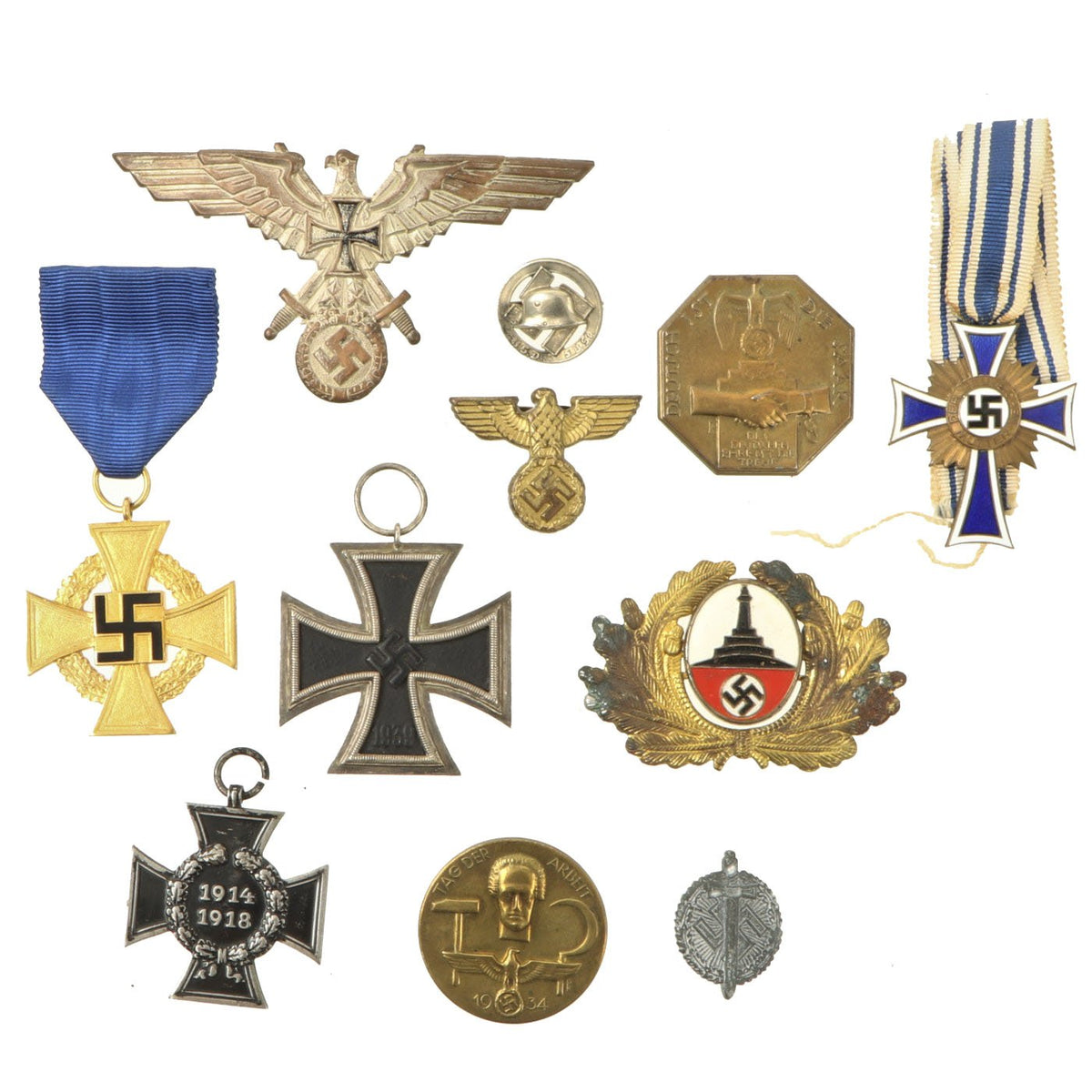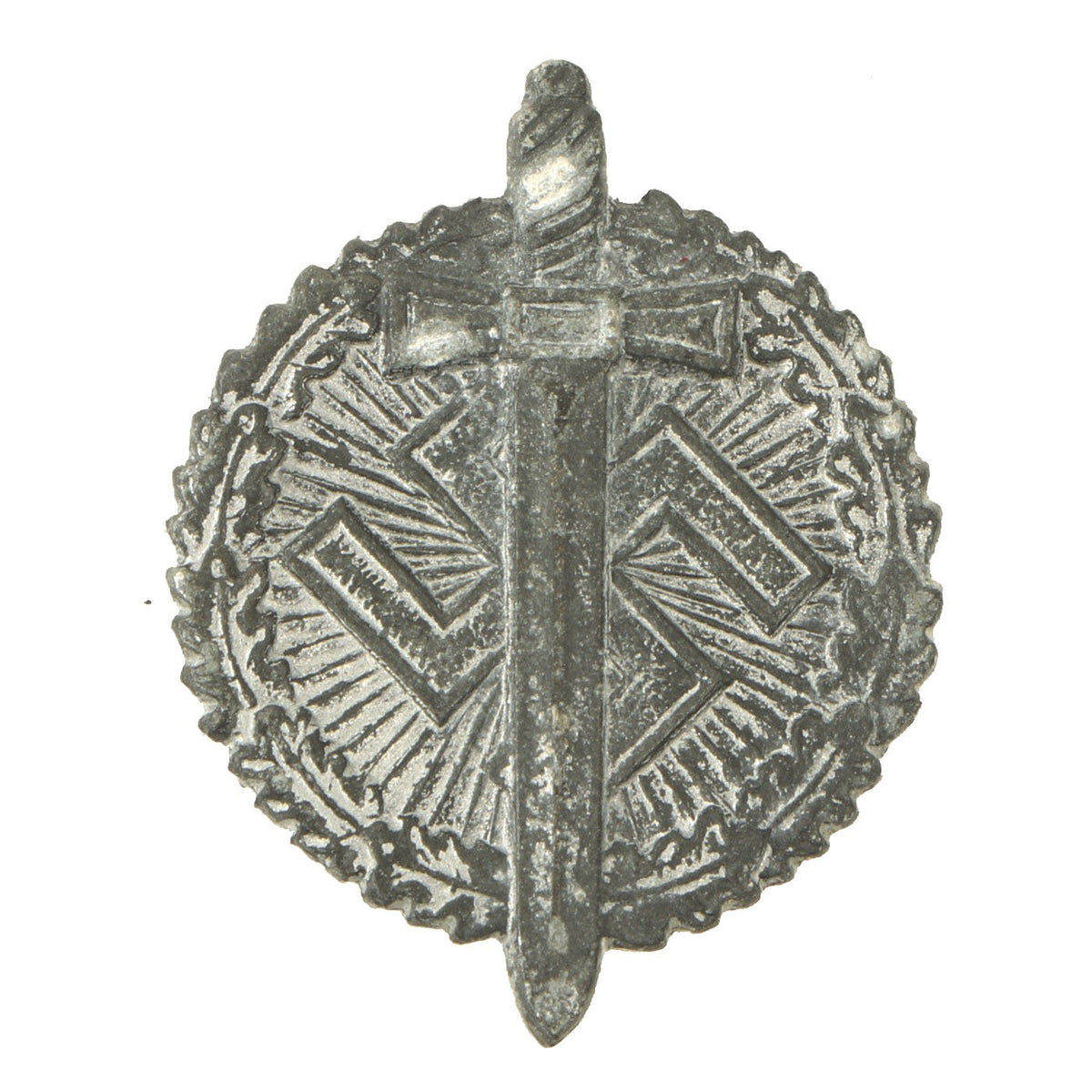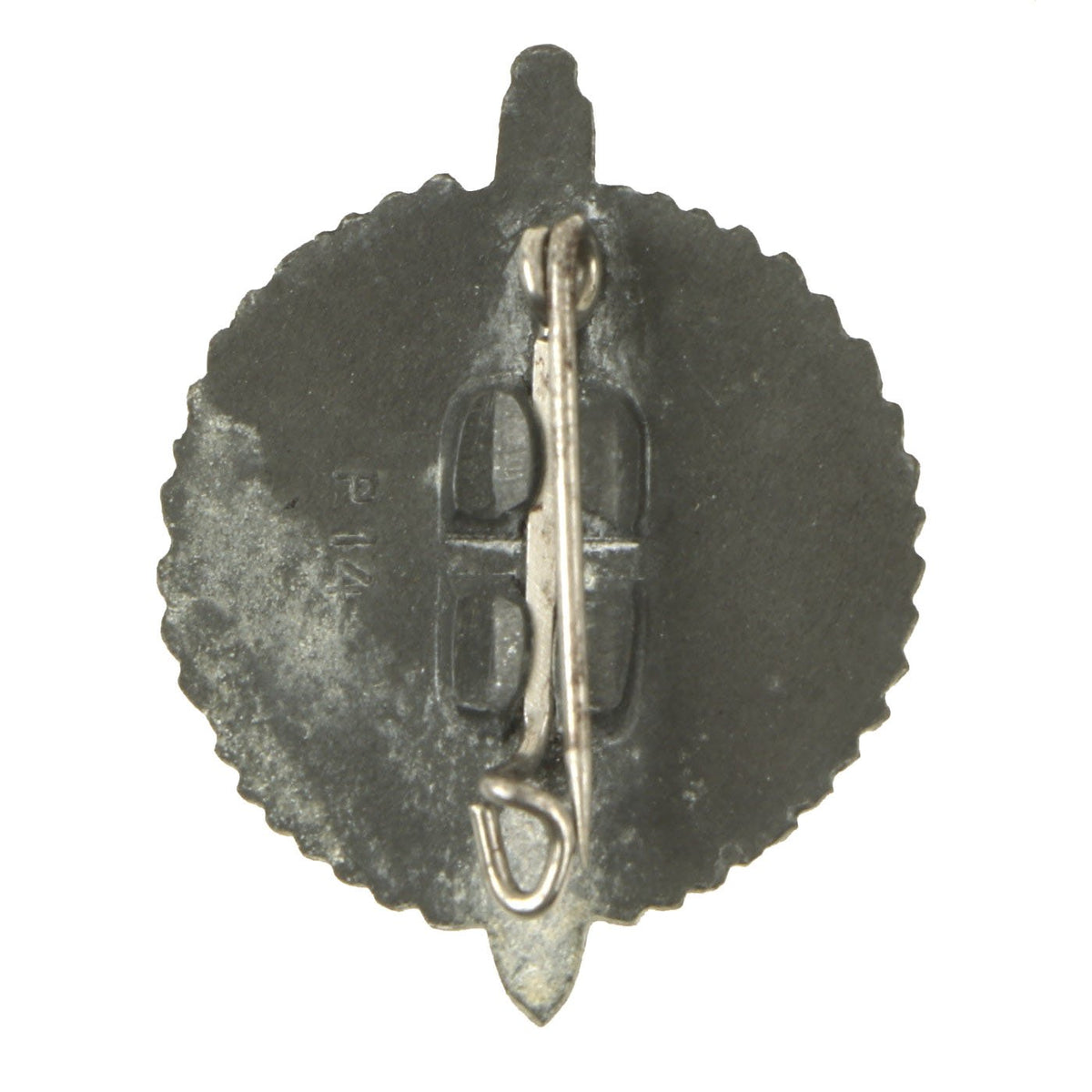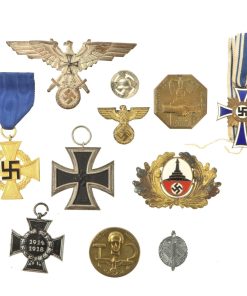Original German WWII Medal & Insignia Grouping with 1939 EKII & Mother’s Cross – 11 Items Original Items
$ 395,00 $ 118,50
Original Item: One-of-a-kind. This is a very nice collection of German WWII Era awards & insignia, with some from the Weimar and Pre-WWII NSDAP period. These were most likely brought home by a WWII USGI during or after the war, as medals from Germany were very popular collectors items.
This is a set of 11 items, some of which are military awards, though some are definitely civilian, and others are badges and/or tinnies. They are all in nice displayable condition, with moderate wear. Some have their original ribbons, while others have lost them. As best we can tell, the set consists of the following:
– German WWII Iron Cross 2nd Class 1939 (Eisernes Kreuz 2. Klasse, or EKII) without ribbon.
– German WWII Faithful Service Decoration 1st Class Cross for 40 Years of Service in excellent condition.
– German WWII Cross of Honor of the German Mother in Bronze (3rd Class) with ribbon.
– German Honor Cross of the World War 1914 – 1918 (Hindenburg Cross) Medal for Widows and Parents.
– German WWII National Socialist German Combatants’ Federation (Stahlhelm)) (NSDFBSt) tinnie pin.
– German WWII National Socialist War Victim’s Care NSKOV donation Pin
– German WWII National Socialist State Veteran’s Association NSRKB Tinnie
– German WWII DEUTSCH IST DIE SAAR 1934 (The Saar is German) Tinnie, issued to commemorate the return of the Saarland Coalfields to Germany. Features shaking hands beneath an eagle and swas (hook Cross)
– German WWII TAG DER ARBEIT 1934 (Labor Day 1934) Tinnie maker marked on reverse.
– German WWII Large Reichsadler badge with Iron Cross and Crossed Swords. Silver washed bronze with a missing pinback.
– German WWII small gold washed bronze Reichsadler pin with intact bent clasps on the reverse.
This is a great set of medals and other awards from Germany. A great way to start your collection!
Below are descriptions for some of the awards:
German WWII Iron Cross (Eisernes Kreuz) 2nd Class:
The Iron Cross (Eisernes Kreuz, abbreviated EK) was a military decoration in the Kingdom of Prussia, and later in the German Empire (1871–1918) and NSDAP Germany (1933–1945). It was established by King Friedrich Wilhelm III of Prussia in March 1813 backdated to the birthday of his late wife Queen Louise on 10 March 1813 during the Napoleonic Wars (EK 1813). Louise was the first person to receive this decoration (posthumous). The recommissioned Iron Cross was also awarded during the Franco-Prussian War (EK 1870), World War I (EK 1914), and World War II (EK 1939, re-introduced with a swas added in the center).
The Iron Cross was normally a military decoration only, though there were instances of it being awarded to civilians for performing military functions. Two examples of this were civilian test pilots Hanna Reitsch who was awarded the Iron Cross 2nd Class and 1st Class and Melitta Schenk Gräfin von Stauffenberg, who was awarded the Iron Cross 2nd Class, for their actions as pilots during World War II.
Please note the edge seam for authentication, which is not present on reproductions. Iron crosses were commonly constructed from an iron core sandwiched in a surrounding two part silver frame, normally the seam of these two silver parts is visible around the edge of the cross as is seen on this fine example.
The Cross of Honor of the German Mother (German: Ehrenkreuz der Deutschen Mutter), referred to colloquially as the Mutterehrenkreuz (Mother’s Cross of Honour) or simply Mutterkreuz (Mother’s Cross), was a state decoration conferred by the government of the German Reich to honour a Reichsdeutsche German mother for exceptional merit to the German nation. Eligibility later extended to include Volksdeutsche (ethnic German) mothers from, for example, Austria and Sudetenland, that had earlier been incorporated into the German Reich.
The decoration was conferred from 1939 until 1945 in three classes: bronze, silver, and gold, to Reichsdeutsche mothers who exhibited probity, exemplary motherhood, and who conceived and raised at least four or more children in the role of a parent. A similar practice, that continues to this present day, was already established in France since 1920, by conferring the Médaille de la Famille française (Medal of the French Family), a tribute to the French mother who raised several children in an appropriate way.
Faithful Service Decoration First Class Cross for 40 Years of Service – A fullsize frosted silver with an oak leaf wreath and black enameled Swas (hook cross) on original ribbon. The Civil Service Faithful Service Medal (Treudienst-Ehrenzeichen für Beamte Angestellte und Arbeiter im öffentlichen Dienst) was a NSDAP Germany medal of honor that was founded on 30 January 1938, in two grades, to reward civilians and military in the employ of the German public services for long and faithful service.
All officials, employees, and laborers at any level of the public service (local, regional or national) who complete 25 or 40 years service were eligible. The second class award was for 25 years of service was a silver cross, with a silver wreath and a black enameled swas in the center of the cross. The first class award was for 40 years of service was a gold cross, with a gold wreath and a black enameled swas in the center of the cross.
The reverse of both classes was stamped with Für treue Dienste (For faithful Services). in German black letter typeface. The ribbon for the medal is cornflower blue.
Hindenburg Cross award for Widows and Parents:
The Honor Cross of the World War 1914/1918 (German: Das Ehrenkreuz des Weltkriegs 1914/1918), commonly, but incorrectly, known as the Hindenburg Cross was established by Field Marshal Paul von Hindenburg, President of the German Republic, by an order dated 13 July 1934, to commemorate the distinguished deeds of the German people during the First World War. This was Germany’s first official service medal for soldiers of Imperial Germany who had taken part in the war, and where they had since died it was also awarded to their surviving next-of-kin. In this case it was a black painted award für Witwen und Eltern (for Widows and Parents).
Shortly after its issuance, the government of NSDAP Germany declared the award as the only official service decoration of the First World War and further forbid the continued wearing of German Free Corps awards on any military or paramilitary uniform of a state or NSDAP Party organization.
Fast Shipping with Professional Packaging
Thanks to our longstanding association with UPS FedEx DHL, and other major international carriers, we are able to provide a range of shipping options. Our warehouse staff is expertly trained and will wrap your products according to our exact and precise specifications. Prior to shipping, your goods will be thoroughly examined and securely secured. We ship to thousands clients each day across multiple countries. This shows how we're dedicated to be the largest retailer on the internet. Warehouses and distribution centres can be located throughout Europe as well as the USA.
Note: Orders with more than one item will be assigned a processing date depending on the item.
Before shipping before shipping, we'll conduct a thorough inspection of the items you have ordered. Today, the majority of orders will be delivered within 48 hours. The delivery time will be between 3-7 days.
Returns
The stock is dynamic and we cannot completely manage it because multiple stakeholders are involved, including our factory and warehouse. So the actual stock may alter at any time. It's possible that you may not receive your order once the order has been made.
Our policy is valid for a period of 30 days. If you don't receive the product within 30 days, we are not able to issue a refund or an exchange.
You can only return an item if it is unused and in the same state as the day you received it. You must have the item in its original packaging.
Related products
Uncategorized
Uncategorized
Angolan Rebel 1970s era 60mm Inert Display Mortar from Angolan Civil War Original Items
Uncategorized
Uncategorized
Uncategorized
Uncategorized
Uncategorized
Band of Brothers ORIGINAL GERMAN WWII Le. F.H. 18 10.5cm ARTILLERY PIECE Original Items
Uncategorized
Uncategorized
Uncategorized
Uncategorized
Uncategorized
Uncategorized
Armored Burgonet Helmet & Polearm from Scottish Castle Leith Hall Circa 1700 Original Items
Uncategorized
Uncategorized
Uncategorized













































































